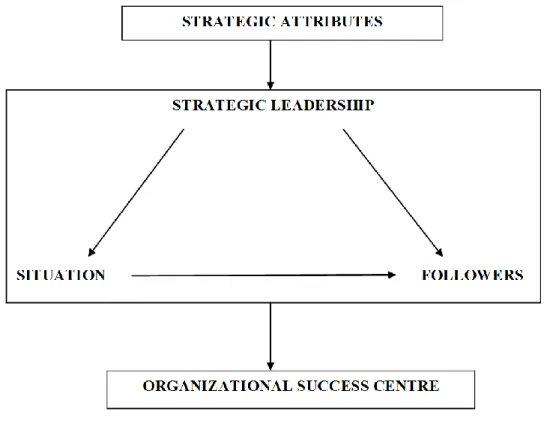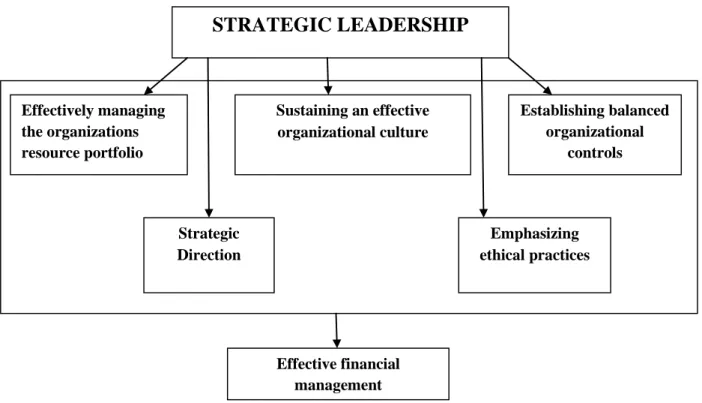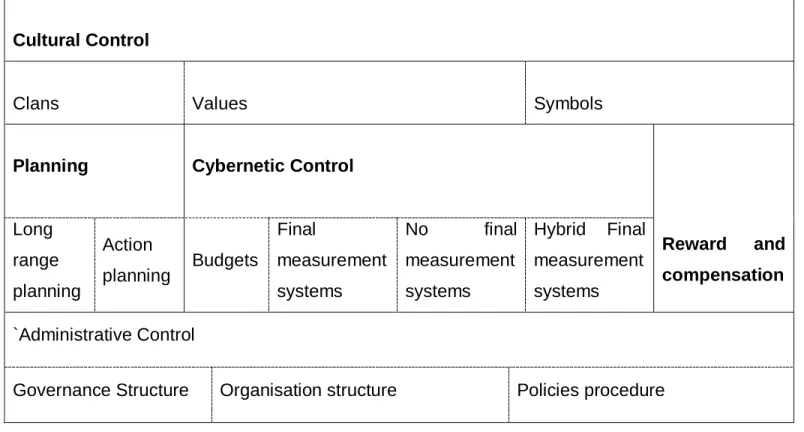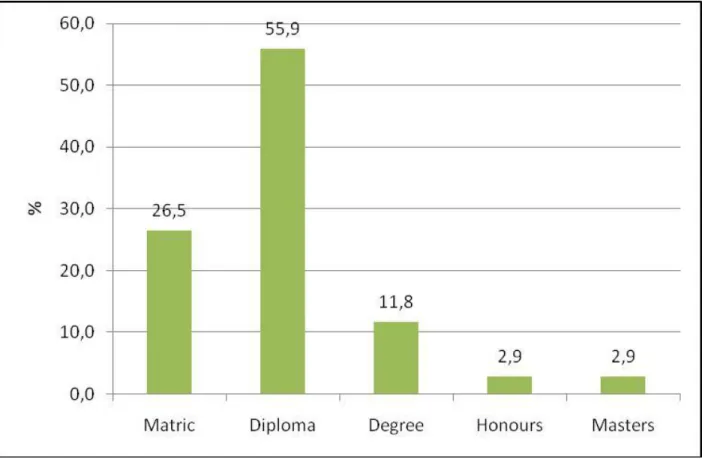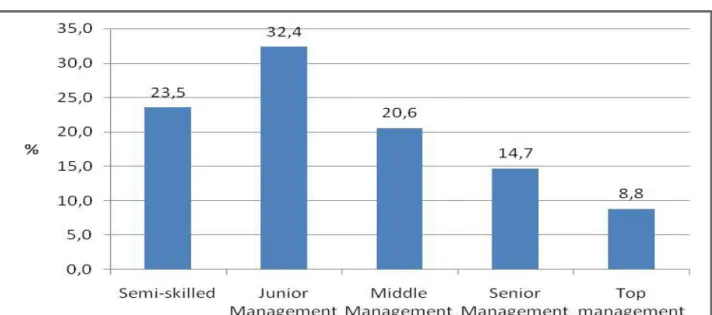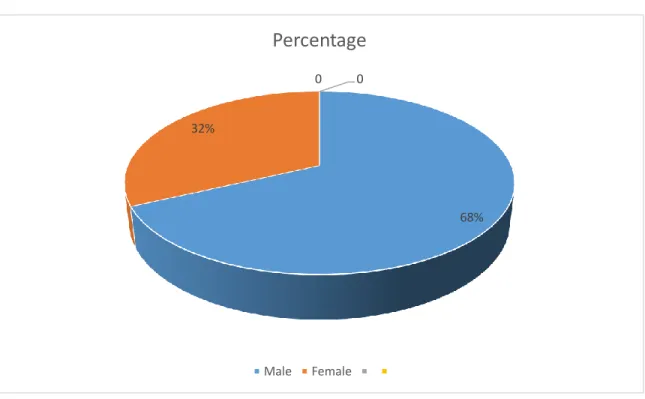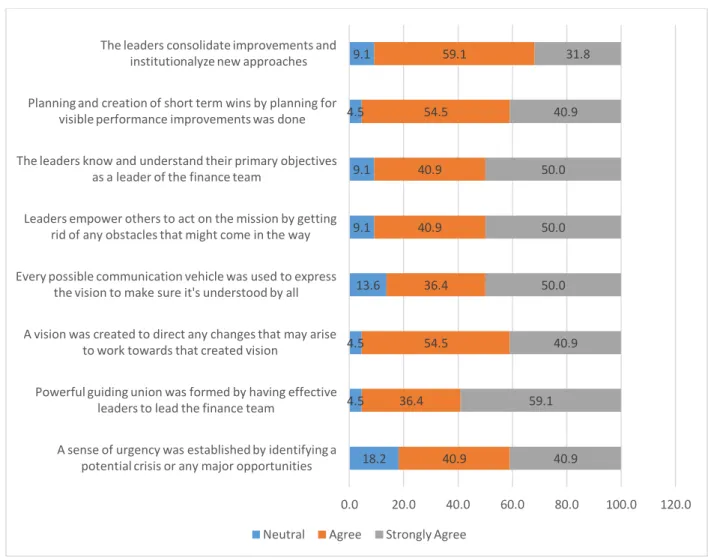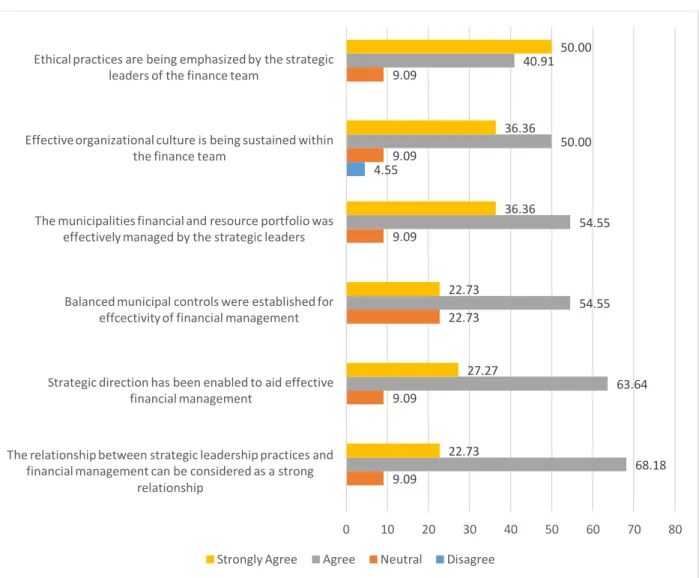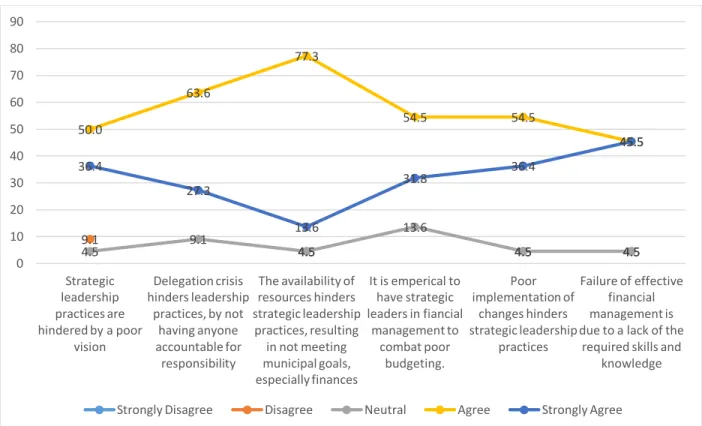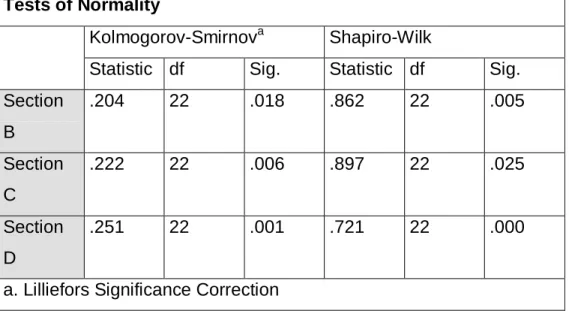i
UNIVERSITY OF KWA-ZULU NATAL
THE ROLE OF STRATEGIC LEADERSHIP PRACTICES IN FINANCIAL MANAGEMENT OF THE ETHEKWINI MUNICIPALITY, KZN.
By
ZASEMBO MKHIZE
Student Number: 208515297
A dissertation submitted in partial fulfilment of the requirements for the degree of Master of Commerce in Leadership
Graduate School of Business & Leadership College of Law and Management Studies
Supervisor: Dr Emmanuel Mutambara
Year of submission 2018
i DECLARATION
I, Zasembo Mkhize declare that “The Role of Strategic Leadership Practices in Financial Management of the eThekwini Municipality, KZN,” Is my own investigation and research. I declare that this research has not been submitted to another institute or submitted for another degree.
Z. Mkhize Date
ii Acknowledgements
Firstly, I would like to thank the almighty God, for this was not done by my own might but it was through his grace and mercy. This was not an easy road but through you father you made it possible, indeed NOTHING IS IMPOSSIBLE WITH CHRIST.
I would also like to take this opportunity to thank my supervisor, Dr Emmanuel Mutambara taking his time and assisting me, giving me guidelines pushing me and never giving up on me. I also acknowledge the support from the eThekwini Municipality staff members that participated in this study and the assistance I received from Miss Nokwanda Mthimkhulu; this would not be possible without your help.
Finally, I would like to thank my family and friends, their unending support and words of encouragement to keep going even though the going got tough they were always there.
A special thank you goes out to my aunt Weziwe, Thabisile (stufuza) and my little sister Omhle who forever understood when I had to be apart from them because of the research. My uncle Patric, who kept telling me that I can do this, and insisted I pursue this degree. My friends, Ntombie Mbobo, Thabie Zondi and Laki Kumalo thank you for your support. These people saw the tears, the hunger and zeal I had for this degree, even when I wanted to give up they were always there for me, thank you. I am truly humbled.
To my late mother, Lungelwa Tshabalala this one is for you, may your soul continue to rest in eternal peace.
iii ABSTRACT
People live in a complex world with vast competition, challenges, and many opportunities that we are faced with. Strategic leadership has thus become one of the vital focus points in organizations and in academics as well. For an organization to be successful, effective, and efficient strategic leadership is imperative together with distinct understanding of the leadership practices involved. This specific study investigated the role of strategic leadership practices in financial management of the eThekwini Municipality, KZN. The main aim of the study was to investigate how the finance department of the eThekwini Municipality adopted the leadership practices and if these were fully known and understood by the department. A positivist (quantitative) approach was used for the study, by using a questionnaire to collect the data. A sample size of 169 participants out of a target population of 300 employees was made use of.
The primary objective was to identify the role of strategic leadership practices in financial management of the eThekwini Municipality. Financial Management is on its own a vital need in the municipality. Having a good and sound finance team will aid the financial stability of the municipality. Strategic leadership practices for ensuring effective financial management were identified in the study proving that the study was effective. It was also confirmed that 59% of the participants strongly agreed that a powerful guiding union was formed by having effective leaders to lead the finance team. Most of the participants strongly agreed to the effectiveness of the leadership practices such as that of being able to plan and create short term wins for visible improvements.
Recommendations made, were to attend to the municipality making sure that resources are readily available to be able to meet organizational goals. The unavailability of resources hinders most processes of the municipality especially that of finance. Another recommendation made was the delegation of responsibility. Every employee should know their responsibility so that one will be able to be accountable for their doings.
iv TABLE OF CONTENTS
Content Page Number
Declaration i
Acknowledgement ii
Abstract iii
Table of Contents iv
List of Tables x
List of Figures xi
List of Acronyms xii
CHAPTER ONE: INTRODUCTION
1.1 Introduction 1
1.2 Background to the Problem 1
1.3 Problem Statement 3
1.4 Aim of the Study 3
1.5 Objectives of the Study 3
1.6 Research Questions 4
1.7 Significance of the Study 4
1.8 Limitations 5
1.9 Summary of literature Review 5
1.10 Brief methodology 6
1.11 Format of the Study 6
v
1.12 Conclusion 7
CHAPTER TWO: LITERATURE REVIEW
2.1 Introduction 8
2.2 Strategic Leadership 8
2.3 Strategy 9
2.4 Leadership 10
2.5 The Evolution of Leadership Theories 14
2.6 Evolving Leadership Requirements 19
2.7 The Model 21
2.7.1 Determining Strategic Direction 22
2.7.2 Exploiting and Maintaining Core Competencies 23
2.7.3 Developing Human Capital 24
2.7.4 Sustaining an Effective Organizational Culture 26
2.7.5 Emphasizing Ethical Practices 27
2.7.6 Establishing Balanced Organizational Controls 28 2.8 Financial Management and its Need in Municipalities 30
2.8.1 Financial Management 31
2.8.2 The Municipality 31
2.8.3 Financial Management Need 32
2.9 The Role of Financial Management 33
2.10 Importance of Financial Management 36
vi
2.10.1. Financial Planning 36
2.10.2. Proper Use of Funds 37
2.10.3. Financial Decision 37
2.10.4. Promoting Savings 37
2.11 Responsibilities within Financial Management 38
2.12 Budgeting and Expenditure Management 39
2.13 Supply Chain Management 41
2.14 Asset Management 44
2.15 Internal Controls and Reporting 46
2.15.1 Internal Controls 46
2.15.2 Internal Finance Reporting 47
2.16 Strategic Leadership Practices 48
2.16.1 Organizational Practices 48
2.16.2 Leadership Practices 49
2.16.2.1 Establishing a Sense of Urgency 49
2.16.2.2 Creating a Vision 49
2.16.2.3 Effectiveness 50
2.16.2.4 Performance Improvements 50
2.17 Strategic Leadership Practices and Financial Management 51 2.17.1 Effectively Managing the Organizations Resource Portfolio 52 2.17.2 Sustaining an Effective Organisational Culture 53
vii
2.17.3 Establishing Balanced Organisational Controls 57
2.17.4 Strategic Direction 58
2.17.5 Emphasizing Ethical Practices 59 2.18 Factors that affect the use of Strategic Leadership Practices 59 2.19 Conclusion 60 CHAPTER THREE: RESEARCH METHODOLOGY 3.1 Introduction 61
3.2 The Research Design 61
3.3 The Research Philosophy 63
3.4 Research Strategies 65
3.5 Target Population 68
3.6 Sampling 68
3.6.1 Non-probability Sampling 69
3.6.2 Probability Sampling 70
3.6.1 Sample Size 71
3.7 The Research Instrument 71
3.8 Questionnaire Construction 72
3.9 Pilot Study 73
3.10 Administration of Questionnaire 74
3.11 Collection of Questionnaire 74
3.12 Data Analysis 75
3.13 Validity and Reliability 76
3.13.1 Validity 76
3.13.2 Reliability 78
3.14 Limitations of the Study 80
3.15 Elimination of Bias 81
3.16 Ethical Considerations 82
viii
3.17 Conclusion 84 CHAPTER FOUR: STATEMENT OF RESULTS, ANALYSIS, AND DISCUSSION
4.1 Introduction 85
4.2 Response Rate 85
4.3 Section A: Demographic Information 85
4.3.1 Age of Respondents 85
4.3.2: Level of education 86
4.3.3 Job level 87
4.3.4: Gender 88
4.3.5: Length of service of the sample 89
4.5 Factors that Hinder the use of Strategic Leadership Practices 90
4.6 Tests of Normality 91
4.7 Correlations 93
4.8 Ranks 100
4.9 Conclusion 103
CHAPTER FIVE: CONCLUSIONS AND RECOMMENDATIONS
5.1 Introduction 104
5.2 Summary of Study Objectives 104
5.3 Conclusion 104
5.3.1 Strategic Leadership Practices for Effective Financial Management 104 5.3.2 Strategic Leadership Practices and Financial Management 105 5.3.3 Factors that Hinder the use of Strategic Leadership Practices 106
5.4 Recommendations 106
5.4.1 More senior members should partake in such research questionnaires 107 5.4.2 Resources should be readily available to meet organizational goals 107 5.4.3 Financial management should delegate responsibility 107
5.4.4 Recruiting skilled and educated employees 107
5.5 Conclusion 108
Bibliography
ix
Appendix A: PERMISSION LETTER
Appendix B: LETTER TO THE PARTICIPANTS
Appendix C: RESEARCH INSTRUMENT
Appendix C: TURNITIN REPORT
x LIST OF TABLES
Table 2.1: Management control systems 58
Table 4.1 Ages of Respondents 86
Table 4.2: Normality test output 98
Table 4.3: Spearman’s rho correlation analysis output 99 Table 4.4: Mann-Whitney Test output for Race 99 Table 1: Mann-Whitney Test output for gender 101
Table 4.6: Kruskal-Wallis Test output 101
xi LIST OF FIGURES
Figure 2.1: Sun Tzu’s model of strategic situationalism 12 Figure 2.2: The Role of selected Strategic Leadership actions 52
Figure 4.1: Level of education of the sample 87
Figure 4.2: Job Position 88
Figure 4.3: Gender distribution of the sample 89
Figure 4.4: Length of service 90
Figure 4.1: Summary of statements from section B 92 Figure 4.2: Summary of statements from section C 94 Figure 4.3: Summary of statements with regards to section D 97
xii LIST OF ACRONYMS
CIO CHIEF INFORMATION OFFICERS HRM HUMAN RESOURCE MANAGEMENT IS INFORMATION SYSTEMS
KZN KWA – ZULU NATAL
RBV RESOURCE – BASED VIEW
SAQ SELF ADMINISTRED QUESTIONNAIRE
SPSS STATISTICAL PACKAGE FOR SOCIAL SCIENCES
1
CHAPTER ONE 1.1 Introduction
Leadership plays a crucial role in any organization as it has been presumed to having affected quite a number of individuals, groups and sometimes the organization as a whole (Kaiser et al., 2008). Stakeholders are challenging strategic leaders with their high demands, by confronting leaders as to whether they can meet up to their demands as an organization. Leaders have a variety of roles and specific responsibilities to adhere to but if the finances are not well controlled, there is without doubt a problem within the leaders in the finance department. There’s a need to be receptive to a range of stakeholders as strategic leaders in the finance department, consequently financial management must formulate a plan to manage the budget effectively and distribute it efficiently.
Leadership should motivate followers, encourage them to do well, synergize small teams and aid organizations in accomplishing goals through the various yet distinctive efforts of these individuals and teams (DeChurch et al., 2010). Despite this reality, most organizations have failed, due to failure of basic team work and failing to understand each other. Many stakeholders would be discontented if there were no available strategic leaders within the financial management of the eThekwini Municipality. This study investigates the role of strategic leadership practices in the financial management of the eThekwini Municipality. The study concludes by making recommendations to the strategic leaders for the enrichment of effective and efficient financial management of the municipality and any strategies for empowerment.
Chapter one introduces the focus of the study, particularly the background to the study, problem statement, the aim of the study, research objectives and research questions as the main sections.
1.2 Background of the Study
There are a variety of definitions for strategic leadership that are provided by literature.
Strategic leadership has also been defined as The leader’s ability to anticipate, envision
2
and maintain flexibility and to empower others to create strategic change as necessary (Hitt et al., 2007). The business dictionary.com, additionally defines strategic leadership as the process of using well considered tactics to communicate a vision for an organization or one of its parts. From the above two statements it can be obtained that strategic leadership needs sturdy leaders that will motivate and lead their fellow employees within a group or organization. Leadership needs strong willed individuals who will lead the people by example and listening to the people’s views and opinions.
Failing to do so will lead to an ineffective leadership.
In 1996, South Africa signed the new constitution which changed the views of the local government for the country, but it has also transformed local government as the central point of government delivery system which led to raising very high expectations for the less fortunate (Mogale, 2003). Local government has been defined as the people who have the authority to make decisions or pass laws in a small geographic area near to them. A very good example of local government is that of the town council. The Marrian Webster dictionary further defines municipalities as a primary urban political unit having corporate status and usually powers of self- government. The local government was promised service deliveries to local communities, stronger, financial performance enrichment of municipalities’ human resource capacity and to reduce the sky-scraping unemployment rate. Municipalities fit perfectly in the local government seeing as they serve of the same purpose; they are for the people even though they have powers of self-government.
It is without a doubt that various municipalities have conversely failed to meet up to their obligations and promises; the outcome resulted with many protests by communities and or municipal employees. SA’s economy is changing quite drastically, requiring strategic leaders to adapt to these set changes accordingly. We now live in a more globalized business environment which requires our leaders to be proficient enough to accommodate all types of environments, both the internal and external environment of the organization (Huey, 1994). There may seem to be a very high failure rate of strategic leaders in financial management which is effective to the local government (Jooste and Fourie, 2009:51).
3 1.3 The Research Problem
Many projects have failed due to poor leadership, decision making, poor work ethic, lack of direction, implementation, and essentially not considering the holistic view (Dooley et al., 2005). Revising strategic objectives and measuring them alongside the metrics used for financial management cases of the eThekwini Municipality would aid this research.
To give proper direction and make prompt decisions, leadership of an elevated caliber is required for a thriving financial management to recognize the advantages and good within an organization. It is however probable that the leaders of the municipality may either not be of a high caliber since some employees mostly say they would not support or encourage others to apply at municipalities. This could be because of the usual office politics, which is expected in most organizations or there is truly a hidden problem with the leaders. This study seeks to investigate the role of strategic leadership practices in financial management in the eThekwini municipality.
1.4 Aim of the Study
The key aim of the study is the investigation of the role of strategic leadership practices within financial management and any deficiencies between financial management in the eThekwini Municipality. Furthermore, findings between management and leadership are presented on any differences or similarities amongst the two. Conclusions and recommendations on what can be improved in any leadership challenges within financial management are also addressed accordingly.
The role leadership plays in the financial management discipline is also investigated, to ascertain it’s significant in financial management projects performed. Likewise, whether the projects were of any success or failures and if any fruitful measures were taken for rectification. The appropriateness for the financial management discipline environment created is investigated to ensure its effectiveness.
2.5 Objectives of the Study
The research objectives of the study were:
4
To establish the strategic leadership practices for ensuring effective financial management at the eThekwini Municipality
To evaluate the relationship between strategic leadership practices and financial management at the eThekwini Municipality
To identify the factors that affect strategic leadership practices for ensuring effective financial management at the eThekwini Municipality.
To recommend on the best strategic leadership practices for effective financial management at the eThekwini Municipality.
2.6 Research Questions
The study explores the role of leaders in general and is set out to answer the following questions:
What are the current strategic leadership practices for ensuring effective financial management at the eThekwini Municipality?
What is the relationship between the strategic leadership and financial management?
What are the main factors that hinder the use of strategic leadership practices for ensuring effective financial management?
What recommendations can be made on the best strategic leadership practices for effective financial management at the eThekwini Municipality
1.7 Significance of the Study
The study is based on eThekwini Municipality one of the main and most effective municipalities within the Kwa–Zulu Natal (KZN) region. Most of us may know some of the roles that a municipality plays or the impact that a municipality has within our different communities depending mostly on the areas we live in and the different challenges we have faced, but having to go in depth about how the leaders within the finance department will give us more enlightenment on how we view a municipality and its leaders. Engaging with some of the employees will reflect how they truly feel about the leadership roles within the finance department. This will pitch in mostly by giving a
5
point of view of the impact the role of strategic leaders in the eThekwini Municipality really has.
The eThekwini Municipality will thus be an excellent example to base most of the comparisons with the other municipalities, as it is a big municipality. This research gives the employees a platform to be able to communicate freely, exclusive of being judged by the decisions they make and correspond how the role of strategic leaders has impacted in their lives.
1.8 Limitations of the study
The limitations to the study that the researcher came across were:
Time Constraints – The data had to be collected within 3 months, but due the busy schedules of the participants, they had to be continuously reminded by doing follow ups and visiting the municipality time and time again.
Confidentiality – Most of the participants were concerned about confidentiality.
Confidentiality was sought and the participants were assured of such, and that also assisted in having more participants.
Connectivity – Connectivity was also a major issue which resulted in delayed responses and having to wait for other responses did delay having to put the work together.
1.9 Summary of literature Review
South Africa is a constitutional democratic country with three spheres of government.
The National, Provincial and Local Government all have their own executive powers and authority, key responsibilities and legislative powers are defined by the constitution of South Africa. Government institutions have a responsibility of providing service delivery to all people of South Africa and all are governed by legislation and the constitution of the country. To provide services to community there is a vital need of good financial management and accountability. According to the past auditor general’s report the eThekwini Municipality has been unsuccessful in obtaining a clean audit opinion. The
6
well-coordinated and clear corporate governance can assist the executive committee to enforce compliance and accountability. According to municipal finance management act council has the responsibility to perform oversight over municipal finances and are accountable for any irregular expenditure that occurs. The aim of the research study is to address these challenges by: reviewing the leadership literature available and extracting the patterns that emerge with regards to effective leadership; determining what effective leadership looks like in a South African context by examining the perceptions, experiences and practices of effective South African leadership and investigating the extent to which the theoretical patterns identified reflect effective leadership practices in South African municipalities.
1.10 Brief outline of research methodology and design
According to Neuman (2013: 142), it is necessary to determine if problems investigated are in fact valid ones. Once this is established, the research can begin in earnest. This research is not an historical review examining developments and improvements over time but rather a methodological and contextual review. With the main aim of the study being to investigate how the finance department of the eThekwini Municipality adopted the leadership practices and if these were fully known and understood by the department, a positivist (quantitative) approach was used for the study.
The research tool that was used to investigate the perceived problems and to elicit primary data was a structured questionnaire, based on a Likert scale. A few open-ended questions were added at the end to ensure depth to the research. Questionnaire responses were analysed using inferential and descriptive data analysis by use of Statistical Package for Social Sciences (SPSS) software. Inferential statistics help to create the relationship between variables and come up with conclusions (Sekaran &
Bougie, 2013:126). Descriptive statistics is described as the statistics that provide descriptive information about a set of data. Graphs and charts were used to present the data findings.
7 1.11 Organisation of the Study
Chapter one: Consists of eight sub- sections, introducing the study, briefly outlining the background of leadership, problem statement, aim of study, the main objectives of the study and questions to be answered, study significance and the conclusion.
Chapter two: The literature review of strategic leadership is provided. It is also divided into sub- sections focusing on strategic leaders, financial management and its need in municipalities, strategic leadership practices, relationship between strategic leadership practices and financial management and the factors that hinder the use of strategic leadership practices.
Chapter three: The research design and the methodology of the study are covered.
How the methodology is conducted is also stipulated, which is a quantitative approach.
The instruments and data collection techniques used are also stipulated.
Chapter four: Results, discussion of findings, analysis and interpretation will also be provided by the researcher.
Chapter five: This final chapter provides recommendations based on the results, discussion and findings of the study, recommendations for the enhancement of effective and efficient financial management by the strategic leaders. Areas of further research are also highlighted.
1.12 Conclusion
Strategic leadership practices have been taken calmly especially by those acquiring leadership roles. The role that strategic leaders play within financial management will establish the impact it has on the eThekwini Municipality employees. It is therefore crucial for leaders to lead by example and to take their roles seriously, taking into deep consideration of those that follow and are being led by them. This chapter provided the introduction, problem statement, research objectives and questions, the aim of the study and the significance of the study. The following chapter looks at the literature review which forms the framework to aid the study.
8
CHAPTER TWO: LITERATURE REVIEW
2.1 Introduction
The previous chapter introduced the study by presenting the background information pertaining to the establishment of strategic leadership practices for ensuring effective financial management, evaluating the relationship between strategic leadership practices and financial management and the factors that affect the strategic leadership practices for ensuring effective financial management at the eThekwini Municipality.
This chapter presents literature related to the study. The main purpose of a literature review is to gain an understanding of the knowledge that is already known, in that specific area of study by reading relevant work to aid ones’ interpretation of the study.
This also includes a means of revealing the established and some accepted facts regarding the study (Kreuger and Neuman, 2006:89). Literature review also assists in understanding past theories that have already been employed by previous researchers.
2.2 Strategic Leadership
Leadership has been defined by many, but according to (Roux, 2005:761), it is having the capability to communicate, enhance, motivate and establish organizational goals.
Having the capability of utilizing the above-mentioned attributes whilst having a long- term direction for the organization and establishing the day to day running of an organization is strategic leadership. Strategic leadership is more in depth and looks more into the future of any prospects within an organization. There has been numerous debates as to whether strategic leadership really matters and its impact in the organization (Boal and Hooijberg, 2001:139). With the development of the upper echelons theory it was further argued that executive’s experiences and their personalities had a huge impact on most of their interpretations hence in turn affected their decisions. The choices being affected were soon visible in the organizations performance.
To fully understand what strategic leadership really means, one needs to separately define the two words and elaborate more on them, that being Strategy and Leadership.
9 2.3 Strategy
Strategy, according to (Jarzabkowski et al., 2007:225) is not merely something that an organization has but what the members of an organization have to abide by and do.
There is no standalone rule that governs strategy but it combines aspects of the past, present and future. However (Cohen, 2004:66) further defined strategy as an art which can be used to achieve victory in our everyday lives irrespective of the circumstance. If familiar strategy principles could be classified than this would be rather invaluable to each organization because that would mean each success would be repeated and used others. The direction in which strategy is executed within any organization leaves a gap when implementing strategy because there is no concrete test model (Lynch, 2000).
Strategy is something that every organization has but of a different caliber, unique and one that is fit for that organization. It involves a set of activities and steps that an organization has to abide by (Porter, 1996).
The organizations strategy must be coordinated with its competitive environment internally and externally in order to be able to survive and compete (Serfontein and Hough, 2011). Strategy is mostly competitive; therefore, an organization has to gain competitive advantage and a particular strategic position to outweigh its competitors.
Strategic positioning is all about being able to outperform competitors, by gaining competitive advantage. Each organization must be able to identify a gap, implementing their strategy aligning it with competitive advantage because each strategic principle is unique to an organization. There are three key principles for strategic positioning which have been underlined by (Porter, 1996) namely that strategy is the creation of a unique and valuable position, involving a different set of activities, requires you to make tradeoffs in competing – to choose what not to do and that strategy involves creating fit among a company’s activities.
Formulating a strategy is key for the top executive leaders within an organization for a strategic leadership role, this however has a great impact on the decisions that the leaders make (Sosik et al., 2005). There are aspects that enhance an organization’s strategy which include: focusing on the core business, constant effective communication, prioritizing initiatives and balancing the risk and rewards (Hartman,
10
2004). The decisions made should be sound strategic decisions, should the decisions made be utterly in the wrong direction this poses questions on the top leaders regarding their strategic leadership abilities. There are various reasons as to why many strategies fail, lack of implementation and resources, unanticipated economic conditions, failure to understand how the strategy is to be implemented and lack of focus (Sterling, 2003). It is therefore imperative to have a financial evaluation of a strategic plan to try and avoid the above-mentioned pitfalls.
While strategy has been defined, it may seem to be a bit vague on the exact steps to follow or how to implement and execute strategy. This merely depends on the strategic leaders of an organization, their understanding of the strategy as there is no right or wrong manner of implementing strategy. It is important to communicate the strategy well and making sure that it is understood by all those involved. There are different leadership levels in all organizations each with their own smaller vision to implement, hence why the vague steps in following the main strategy.
2.4 Leadership
Leadership serves as a framework for any organization, mainly for the success of the organization. Being a motivator, teacher, visionary, enabler and mentor are a few attributes that a leader should entail for the success of an organization (Serfontein and Hough, 2011). Leadership may be interpreted in various ways because there are many forms of leadership. Leadership of the organization can be divided into the environment, strategy and organization (Crossan et al., 2008). However, (Bolden, 2004:4) further elaborated in the difference of opinion in which leadership is defined is mainly through the influence of one’s theoretical stance. Others view it as characteristics that ‘leaders’
possess and then the others view it as a societal procedure that develops from relationships. The difference in views will thus continuously result in the differentiation of opinions regarding leadership.
In as much as being a leader has all the positive traits, it does not necessarily mean that all leaders are good leaders; others are deceitful and would do just about anything to get their way. To further elaborate this point, (Kellerman, 2004) stated the following, scholars should remind us that leadership is not a moral concept. Leaders are like the
11
rest of us: trustworthy and deceitful, cowardly and brave, greedy and generous. To assume that all leaders are good people is to be willfully blind to the reality of the human condition, and it severely limits our scope for becoming more effective at leadership.
The psychodynamic approach further brings more areas of consideration. It raises questions as to what psychological factors bring about people to become leaders and followers, what gives rise to organizations and society of the perception of leadership?
This alone gives rise to the importance of understanding oneself, those around you and basically the nature of leadership amongst leader and follower (Stech, 2004). With any role one plays, being it in the workplace or at a home, as a leader or follower it is empirical to always consider those around you. One review of leadership theory by (Northouse, 2004) who defined themes on how leadership is now being conceived:
1) Leadership is a process;
2) Leadership is influential;
3) Leadership appears whenever an assembly is involved; and 4) Leadership comprises achieving a goal.
Figure 2.1 below illustrates how most leadership attributes are perceived and how they lead to the success of the organization.
12
Figure 2.1: Sun Tzu’s model of strategic situationalism (Chen and Lee, 2008).
Redefining strategy and leadership is change itself, even though the result is that the two are more or less alike (Abell, 2006). The increasing arising challenge is the growth of leadership, making it important to therefore take the advantage of the ever-changing world, grab the chance before the competitors to realign the organization, its functional and business activities.
The most common type of leadership for organizations is transformational leadership, this type of leadership is whereby the leaders are able to motivate, inspire and promote change in their respective and distinctive roles and organization respectively (Hall et al., 2002). If carried out in the appropriate manner, transformational leadership will be able to willfully direct and promote organizations in the right direction for success.
Information System leadership is another type of leadership, whereby little form is known and has been researched about it, yet information systems in organizations has become one of the most dependent variables for business processes (Karahanna and
13
Watson, 2006). This makes it difficult for leaders to be able to balance the normal operations, therefore Chief Information Officers (CIO) are thus expected to collaborate both information systems technical skills with that of the organizations operational functions.
Creative leadership is essential for highly performing individuals especially for the success of an organization. Creativity on its own will not result in a successful organization. The leader has to have the urge, be unique as there are no special skills and traits of being creative (Harris, 2009). It is basically how one uses their imagination to secrete the creative juices that will be just for a successful organization. This leads to (Sosik et al., 2005) pointing out the importance of strategic leadership, how leaders should be able to utilize all available components and be able to strategize by also understanding the (IS) technology. Almost half (40%) of all (IS) technology are cancelled even before completion due to a lack of strategic leadership. Furthermore, (Boal and Schultz, 2007) elaborates that strategic leadership promotes a rather peculiar attraction in organizations, providing a balance of complex systems, guiding inter actions of others and transferring different kinds of resource flows.
A question that arises is if leadership can be taught. However, (Kouzes and Posner, 2006) further supports this question as to stating that leadership can be taught but to a certain extent. Leadership is not all about being a leader nor is being a leader just about maintaining a certain position or a status quo in an organization or community. It is far more fulfilling to believe that anyone who wants to lead can be leader, than to know that being a leader cannot be learnt which is quit dooming for those that had a desire to be a leader. One important aspect for an individual under some form of leadership is to understand the link between practice and process (Carroll et al., 2008), this making an individual aware of the actions and interactions that make up leadership. The connection between practice and control would also appear to be a critical one for leadership.
14
SA economy has changed drastically with a high level of technology usage, which continuously brings about change, innovation and improving processes. Leadership deals with a lot of mentality, meaning that there are more personnel involved rather than just projects and machinery doing all the work. With South Africa’s own democratic change, what kind of leadership is then required in the eThekwini Municipality? Perhaps it is the leaders that who bear to take risks and will be able to motivate their employees who will create an environment that will be conducive enough for all types of leaders, this being the former and the latter.
2.5 The Evolution of Leadership Theories
As a concept, leadership has a universal appeal and much has been written about it in the popular press and academic research literature (Northouse, 2001). The demand for this understanding has been fuelled:
i) At an organizational level; as companies, based on the belief that leaders add value to the success of the organisation and that the perceived task of being a leader has grown and become more challenging over the years, seek to determine scientific methods to recruit and develop individuals with leadership abilities (Channer et al, 2001);
ii) At the individual level; as people seek out books and information on how to develop their leadership skills, improve how they present themselves to others and develop their career prospects (Channer et al, 2001)
In a bid to understand and master leadership, theorists have been deconstructing it and developing formulas to predict what makes effective leadership. As a result, several leadership theories have emerged that analyse the concept from different angles. One of the key challenges in attempting to understand the concept of leadership (from a theoretical perspective) is that it has been explained as: a 'property' i.e. a set of characteristics, behaviours and attributes that make certain people more effective at attaining a set of goals ('personalists'); a 'process' i.e. the effort by the leader, that draws on various bases of power, to influence members and direct their activities
15
(situationists) and/or a combination of both 'property' and 'process’ elements (Kets de Vries, 2001).
Examples of 'property' theories include: the ideal traits and psychodynamic approaches to leadership. Examples of ' process' theories include: the style, situational, path goal and contingency approaches to leadership. Examples of 'property' and 'process' combination theories include: the transformational approach to leadership, principle centred leadership, the emotionally intelligent leader, the spiritually aware leader and action logics leadership. Each theory has been proposed to further define and explain what makes an effective leader. However,
finding one's way in the domain of leadership is like wandering through a forbidding wilderness that offers few beacons or landmarks' (Kets de Vries, 2001 :213).
i) Great Man Theory (1840 onwards)
The focus here is on leader as hero, as described by Thomas Carlyle in 1840. Herbert Spencer (a fellow Victorian) later expressed a contrasting view that heroic leaders are the product of their time and its prevailing social conditions. Although Carlyle is credited with initiating this phase of theorising, many before him wrote that a leader was born, not made. Plato, Lao-tzu, Aristotle – and even Machiavelli – each contributed to this way of thinking. Though the historic timeline consistently plants the Great Man Theory in the 19th century, we can see its deep roots present in many of today’s practical assumptions about leadership. While there are minor adjustments, the heroic leader remains rooted in individualistic cultures. Iconic figures continue to capture our imagination, whether they be Abraham Lincoln, Winston Churchill, or Nelson Mandela;
Jack Welch, Steve Jobs, or Elon Musk; Albert Einstein, Norman Borlaug or Stephen Hawking. The shift today is toward system leaders – individuals who have the expertise to contribute and who recognise that wicked problems can only be solved through collaboration. Even so, many people – followers and leaders – still hold fast to the assumptions underpinning Great Man Theory, and this influences their cultural behaviour. Trait theory is built upon the idea that leaders possess certain qualities or traits and are different to other people. This led researchers to identify characteristic
16
traits, with the assumption that some finite number could be quantified – and used as a filter to identify leaders.
ii) Trait Theory (1910-1948)
The paradigm shifted with the realisation that the identified traits lacked consistency. In part, this was because no relationship was established between the traits and leadership, and the context of the leader was not considered. The turning point was Stogdill’s (1948) survey of 25 years of research, in which he concluded that a person does not become a leader by the possession of some combination of traits. As a result, leadership research shifted away from traits (the internal factor) and towards behaviours – the external expression of leadership. However, the assumption that leaders have certain traits continues, and is once more being studied. Today’s researchers find correlations between certain personality characteristics (charisma, extroversion, conscientiousness, integrity, and achievement motivation) and leadership. With advanced research methodologies – including neuroscience – there is a renewed sense that defined traits can be used to identify potential leaders, explain leadership and play a part in its development.
iii) Behavioural Theory (1950-1970)
The shift in thinking here was, if people cannot nail down the internal traits, they can look at the external behaviours of leaders. As attention moved to behavioural expressions of leadership, the nature vs. nurture question came to the fore. Are you born – or can you learn – to be a leader? With this new emphasis, and under the right conditions, leaders were seen to emerge as a product of their environment, as well as their nature. Two studies (Katz, Maccoby, Gurin & Floor in 1951, and Stogdill & Coons in 1957) identified two primary considerations: task-oriented vs. relationship-oriented leadership. Engagement with followers also became relevant. However, there was still no consistency in behaviours across tasks or situations. In other words, the variables of context confounded the findings. This led to a new focus - on contingency theory.
iv) Contingency Theory (1967-1990)
17
Contingency theories were developed to account for these contextual variables. They took account of the people involved, tasks required, situation experienced, nature of the organisation, and other environmental factors. This research acknowledged that no single style of leadership was universally appropriate. It’s often the case that the successful turnaround leader struggles in a mature and stable organisational context, just as a leader who flourishes in a stable environment may flounder in a turnaround situation. Fiedler (2010), who is recognised as one of the trailblazers in this area, identified three managerial components: leader-member relations, task structure, and position power. Some contexts favoured leaders who were task-oriented, and some favoured those who were relationship-oriented. Hershey and Blanchard’s situational research (1969) suggested that developmental levels of individuals influenced their leadership styles. Other researchers continued their exploration until interest in this area began to dry up...not surprisingly, with the aging of its foremost proponents.
v) Leader-Follower Theory (1990 onwards)
The role of followers (a contextual variable) was a natural extension of contingency theory. This was a significant departure from the Great Man Theory and its concept of heroic individuals leading from the front. One lasting influence prior to this era is the work of Greenleaf (1970) on Servant Leadership, which emphasised the choice of certain leaders to serve their followers, empowering them to live and work to their full potential. As Greenleaf wrote, the best test and difficult to administer is whether those served grow as persons; do they, while being served, become healthier, wiser, freer, more autonomous, more likely themselves to become servants. And what is the effect on the least privileged in society; will they benefit, or, at least, will they not be further deprived? Leader-member exchange theory is another example (Graen and Uhl-Bien, 1995). Here, high quality relations are characterised by trust and respect between leader and follower, while those of lower quality coincide with transactional and contractual obligations. High quality relations are empirically shown to produce better leader outcomes. (Gerstner & Day, 1997; Ilies, Nahrgang, & Morgeson, 2007).
vi) Transformational Leadership Theory (1985-2010)
18
According to Burns (1978), leadership, introduced the concept of transforming rather than transactional leadership. While both are needed, the author focused on a relationship of mutual stimulation and elevation that converts followers into leaders and may convert leaders into moral agents. This mutuality deepens the work of leader- follower theories and adds a moral dimension. The concept detailed the structure of transformational leadership to include: 1) idealised behaviours (walking the talk), 2) inspirational motivation (offering a compelling vision), 3) intellectual stimulation (approaching problems from multiple angles), and 4) idealised attributes (showing strong character in working for the good of the whole).
vii) New Directions in Theory (2010 onwards)
Contextual school of leadership New contextual factors now being considered include:
national culture, hierarchical levels of leadership, gender, race, etc. Contextual factors are seen to empower – or inhibit – leadership behaviours and outcomes. Ethics and moral development Researchers are looking at the influence of ethics and morals on the behaviour of leaders (and on organisational outcomes). Biology and neuroscience Work is being done on behavioural genetics of leadership emergence, leadership role occupancy, effect of hormones on correlates of leadership, neuroscience perspectives, evolutionary points of view, integrative biological perspectives, and the socio-biology of leadership (Day & Antonakis, 2011).
viii) System Leadership Theory (2015 onwards)
Our awareness of the interconnected world has led to an appreciation of the systemic nature of contemporary issues (Senge, Hamilton, and Kania, 2015). System leadership recognises that collaboration is essential to solve wicked problems (Heifetz, 1994;
Heifetz, Kania, and Kramer, 2004). Building on decades of leadership research and practice and raising questions about our collective responsibility for solving wicked problems, we can understand some of the characteristics of – and need for – true system leadership. Much like Jim Collins’ Level 5 leaders (2001), they have deep humility and fierce professional resolve. The difference is that they have moved from individual to collaborative responsibility for the whole. Ego is sacrificed for the common
19
good. The consideration of multiple points of view is essential. Envisioning and creating the future together replaces reactivity.
External constraints and obstacles are engaged within leaders in order to be resolved for the system itself. The valuing of emergent insights deepens trust and disciplines action. Individual – and collective – development leads to system development. In 2014, Frederic Leroux’s Reinventing Organizations: A Guide to Creating Organizations Inspired by the Next Stage of Human Consciousness gave us fresh insight into the changing requirements for leadership in organisations. He offers the metaphor of the organisation as a living system, acknowledging its modern-day complexity within our dynamic social and economic culture. Just as Senge et al have noted, an individual, working alone, is unable to satisfy today’s mix of personal, organisational, and global demands. Leaders at every level in these cutting-edge organisations are recognised by relinquishment of personal ego and organisational control, trust in their colleagues and organisational systems. These factors allow them to self-organise for the good of the whole – with an emphasis on authenticity, collaboration, and distributed authority.
2.6 Evolving Leadership Requirements
As noted above, one of the key themes to emerge from the review of the theories relates to the chronological evolution of leadership theory. This is, in many respects, driven by the evolving (changing) requirements and expectations of leaders within an organisational environment. It is this evolutionary aspect of leadership requirements that further complicates the understanding of the concept and impacts on the ability of the practitioner to create interventions to support its development. To support changes in the organisational operating methods, leaders need to adopt new ways of leading within these organisations. As these new elements of leadership (skills and behaviours) are identified they are added to the theories and thereby increase their complexity.
Naplotano and Henderson (2008) argue that whilst it was previously clear that leaders should operate as answer providers, order givers, problem solvers and brokers, new operating methods within organisations mean that leaders are now required to act differently. Sexton and Smilor (2016) propose four key changes in organisational
20
systems that in turn produce new demands on leaders. It is a result of these new demands that leaders are required to adopt different leadership styles and approaches.
The first key change proposed relates to the shift from local, simple enterprises to global, complex and large organisations. In a local and simple enterprise, the needs were for autocratic and patriarchal styles of leadership where decision-making could be held in the hands of one person. In larger, global organisations the demand is for leaders to find order in chaos, push the organisation forward and design systems that allow it to grow. Thus, the changes in operating structure have created a shift in leadership requirements from autocrat to analyst and architect.
The second change proposed by Sexton et al. (1996) relates to the shift in focus from meeting material needs to meet the psychic needs of an individual. Based on Maslow's proposal that an individual's basic needs must be satisfied to allow more abstract needs to be met, Sexton et al (1996) argue that in underdeveloped countries where an individual's livelihood is uncertain, people will be more inclined to look towards a father type figure to meet their basic needs. In developed countries, however, leaders are required to be receptive to the more abstract needs and desires of individuals. In line with this Charlton (1992) suggests that leadership involves a paradigm shift from viewing employees as children to creating adult expectation which offers meaningful work and involvement as a means of accessing human potential. In terms of leadership style, for a leader to meet the expectations of employees it is argued that such changes shift the role of leadership from a father figure role to that of a catalyst. servant and developer of people.
The third key change proposed by Sexton et al (1996) relates to a shift in organisational structure i.e. many large organisations are moving away from top heavy, hierarchical organisational structures to flatter or project based organisational structures. In the 'old world' autocratic authority relationships, rigid and time-consuming decision-making structures and control leadership styles served to ensure that the organisation functioned (Charlton,1992). In the new world' leaders are required to create organisations that allow for the expression of potential (Chariton, 1992) and as such
21
flexibility. Negotiation and strength are the characteristics that define the new leadership style required.
The final key change relates to the shift from mono-cultural and univocal organisations to multi· cultural and multi-vocal organisations. Because of advancements in technology and shifts in social, economic and political factors, national and international boundaries that previously isolated organisations, have disappeared. All organisations are now faced with managing cultural diversity and listening to the voices of those from different cultures. In terms of a shift in leadership style, leaders are required to act as listeners who are able to find ways bring about mutual learning and appreciation (Sexton et al, 2016), The above framework contributes to the understanding of leadership in that it highlights the evolutionary nature of leadership requirements i.e. that different leadership styles and practices will be required as organisations grow and reinvent themselves. The framework provides a broad generalized view of how many organisations are changing also provides insight into the types of leadership styles that may be appropriate and relevant to meet the changing requirements of an organisation.
Finally, the framework reinforces the notion that leadership does not sit in isolation, but rather impacts upon and is impacted upon by the environment. In terms of limitations, the framework only addresses organisational changes as they stand to date. The framework does not offer additional insight into what future leadership styles and practices will be required to ensure business success. In addition. The broad view that organisations are shifting from the 'old world' to the 'new world' ignores the fact that different parts of the same organisation may be at different stages of rein vent ion. As such these organisations may require a combination of ' old world' and 'new world' leadership styles.
2.7 The Model
According to the authors Hitt, Ireland, and Hoskisson (2003) strategic leadership must be action oriented, hence the decisions made should spur the company to action. These decisions and actions can make strategic leaders a source of competitive advantage
22
thus, through the value created by their strategic actions. Hitt et al. (2003) have developed a framework for strategic leadership, with six critical components essential for effective leadership. These components enable leaders to take actions that contribute to the effective use of the firm's strategies. These strategic actions will be explored in detail below:
• Determining strategic direction
• Exploiting and maintaining core competencies
• Developing human capital
• Sustaining an effective organizational culture
• Emphasizing ethical practices
• Establishing balanced organizational controls 2.7.1 Determining Strategic Direction
Strategic direction means the development of a long-term vision of a firm's strategic intent. The vision, which is typically 5 to 10 years into the future, consists of the image and character the firm seeks. Having a vision for the future and communicating that vision to others are essential components for great leadership. Bateman and Snell (2004:366) define a vision as a mental image of a possible and desirable future state of the organization and it expresses the leader's ambitions for the organization. A vision should be ideal (communicating a standard of excellence and a clear choice of positive values) and unique (communicating and inspiring pride in being different from other firms).
Strategic intent, according to Hagen et al. (2001: 39) means the leveraging of a firm's resources, capabilities, and core competencies to accomplish what may at first appear to be unattainable goals in the competitive environment. It exists when all employees are committed to the pursuit of a specific performance criterion, and it provides employees with a goal worthy of personal effort and commitment. Przybylowicz and Faulkner (1997: 150) suggested that to be effective, strategic intent must create a sense of urgency, be competitor focused, search for weaknesses in competitors' positions which can provide competitive advantage if properly addressed and must remain stable
23
over time while being flexible as to the means used to achieve the intended goals.
When employees believe in their company's product and industry and are totally focused on the firm’s ability to outperform competitors, then strategic intent has been effectively formed (Hitt et al. 2003).
Strategic mission on the other hand, is a statement of a firm's unique purpose and the scope of its operations in product and market terms (Hitt et al. 2003:23). It provides a strong sense of what the firm wants to do (a description of the products the firm intends to produce and the markets it will serve) and of the ethical standards that will guide behaviours in the pursuit of its goals. Together strategic intent and strategic mission yield the insights required to formulate and implement strategies. It is not simple for leaders to create a sound direction. They need to consider a wider array of factors during decision-making, which would increase the likelihood of success.
2.7.2 Exploiting and Maintaining Core Competencies
Core competencies generally relate to an organization's functional skills such as manufacturing, finance, marketing, and research and development. According to Prahalad and Hamel (1994) they involve all levels of people and all functions and are the bases on which to build strategies. They went on to say that core competencies are the collective learning in the organization, especially how-to co-ordinate diverse production skills and integrate multiple streams of technology (Prahalad and Hamel, 1990:82). Hitt et al. (1994:30) define core competencies as organizational skills around which a firm builds a competitive advantage. Ireland and Hitt (1999:49) state, the relatively unstable market conditions resulting from innovation, diversity of competitors, and the array of revolutionary technological changes occurring in the new competitive landscape have caused core competencies rather than served market to become the basis upon which firms establish their long-term strategies.
Core competencies are the resources and capabilities serving as a source of competitive advantage for a firm over its rivals and allow organizations to produce and
24
deliver products that have unique benefits and value for customers (Prahalad and Hamel, in Hagen et al. 2001). Ireland and Hitt (1999:49) maintain that in the 21st century, an ability to develop and exploit core competencies will be linked even more positively and significantly with the firm 's success. Prahalad and Hamel (1990) assert that in the long run, competitiveness lies in the ability to build, at a lower cost, and faster than competitors, the core competencies that generate unanticipated products. They add (Prahalad and Hamel, 1990:81), the real sources of advantage are to be found in management's ability to consolidate corporate wide technologies and production skills into competencies that empower individual business to adapt quickly to changing opportunities. It is the task of strategic leaders to ensure that the firm's competencies are emphasized during the strategy implementation efforts (Hitt et al. 2003).
Strategic leaders should make decisions that help the firm develop, maintain, strengthen, leverage and exploit core competencies. Hagen et al. (2001) add that exploiting core competencies involves sharing resources across units. Core competencies do not, like physical assets, deteriorate with use they grow. In fact, they are enhanced as they are applied and shared. They, however, need to be nurtured and protected. Competencies are the glue that bind existing business, and are the engine for new business development (Prahalad and Hamel, 1990:82). However, for a firm's resources and capabilities to be identified as core competencies, they should be valuable, rare, costly to imitate and should have no equivalent substitutes (Ireland and Hitt, 1999). Hagen et al. (2001 :41) add, the most effective core competencies are based on intangible resources, which are less visible to competitors because they relate to employees' knowledge or skills.
2.7.3 Developing Human Capital
Human capital refers to the knowledge and skills of a company' s workforce. The workforce, the employees, is viewed as a capital resource that requires investment. This investment results in a creative well-educated workforce, and as Ireland and Hitt (1999:50) said, in the global economy significant investments will be required for the
25
firm to derive full competitive benefit from its human capital. According to Hitt et al.
(2003:397) the effective development and management of the firm's human capital may be the primary determinant of a firm's ability to formulate and implement strategies successfully. Hence, building human capital is vital to the effective execution of strategic leadership and strategic leaders therefore need to acquire the skills needed to help develop employees in their areas of responsibility.
Bennis (2013) also stated that without leaders who can attract and retain talent, manage knowledge, and unblock people's capacity to adapt and innovate, an organization's future is in jeopardy. An effective Human Resource function is a crucial, intangible asset for companies with respect to Competitive Advantage. Hitt et al. (2003) maintain that core competencies cannot be effectively developed or exploited without appropriate human capital. Hence, taking on board and keeping the right people is crucial to gaining a competitive advantage in today's rapidly evolving business world. Hitt et al. (1994) added that the development of human capital is critical for strategic competitiveness.
One of the world's most accomplished business leaders, Jack Welch, believes in human capital development and emphasized selecting the right people, allocating capital resources, and spreading ideas quickly as the main tasks of a leader.
With the new competitive landscape comes the growing need for good, new ideas.
Knowledge management as described by Bateman and Snell (2004:8) refers to the set of practices aimed at discovering and harnessing an organisation's intellectual resources, fully utilising the intellects of the organisation's people. It is about finding, unlocking, sharing and capitalising on the most precious resource of an organisation, the people's expertise, skills, wisdom and finally their relationship. Companies need to find these human assets, help people collaborate and learn, generate ideas and harness these ideas into successful innovations. This brings up the concept of intellectual capital, the collective brainpower of organizations (Bateman and Snell, 2004:9). It is important that companies know how to attract good people, make them want to stay and inspire them to consistently come up with creative ideas. The goal is
26
for companies to turn the brainpower of their employees into profitable products (Bateman and Snell, 2004:9).
According to Hagen et al. (2001) human capital can be developed through training and development, thus management development programs which can help build skills and facilitate communication among employees by providing a common language, building employee networks, and constructing a common vision of the firm. These programs also help employees acquire skills that are critical to an organization's primary operations, core competencies, and customers. Furthermore, because development programs socialize and help instil a common set of core values, they promote cohesion among employees.
2.7.4 Sustaining an Effective Organizational Culture
Organizational culture refers to the complex set of ideologies, symbols, and core values in a firm (Hitt et al. 2003). These are the glue that keeps people together in organizations (Fernandez and Hogan, 2003), as they provide a sense of shared meanings and morals. Culture is rooted in history and is concerned with decisions, actions, communication patterns, and communication networks (Ireland and Hitt, 1999:51).
Shaping the organization culture, the context within which the organization formulates and implement its strategies, is a central task of effective strategic leadership because it influences the way things are done in the organization. Leaders are thus involved in managing the culture by establishing an explicit strategic direction, communicating that direction, and defining the organizational vision and value (Homer, 1997:272).
Fernandez and Hogan (2003:38) added, an organization's leaders define the organization's core values, underlying attitudes and beliefs that strongly influence individual and group behaviour Firms can develop core competencies in terms of the capabilities it possesses as well as the way these capabilities are used to produce
27
strategic actions. A firm can thus have a competitive advantage in the way capabilities are used to produce strategic actions.
Organization culture influences how the organization conducts its business and helps regulate and control employees' behaviours and hence it can be a source of competitive advantage. Lippit (2003) accentuates that the competitive advantage that is the hardest to replicate is internal culture. In the global economy, strategic leaders capable of learning how to shape a firm's culture in competitively relevant ways will become a valued source of competitive advantage (Ireland and Hitt, 1999:51). Strategic leaders must develop and nurture an appropriate culture, one that promotes focused-learning and human development, the sharing of skills and resources among units in the firm, and the entrepreneurial spirit important for innovation and competitiveness (Hagen et al.
2001:40). Hitt et al. (1994:31) concurred when they said, an effective culture is one that promotes appropriate levels of risk taking and fosters an entrepreneurial spirit. Such culture creates an emphasis on strategic actions linked with the pr
